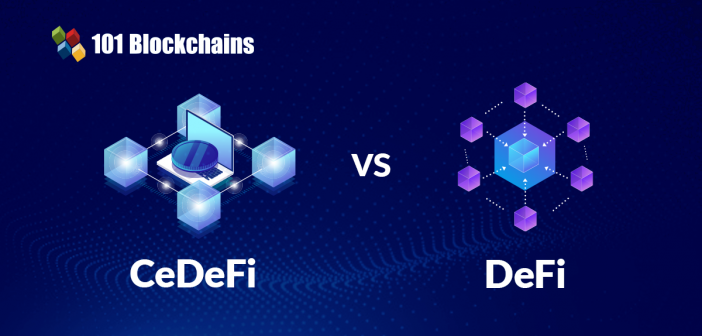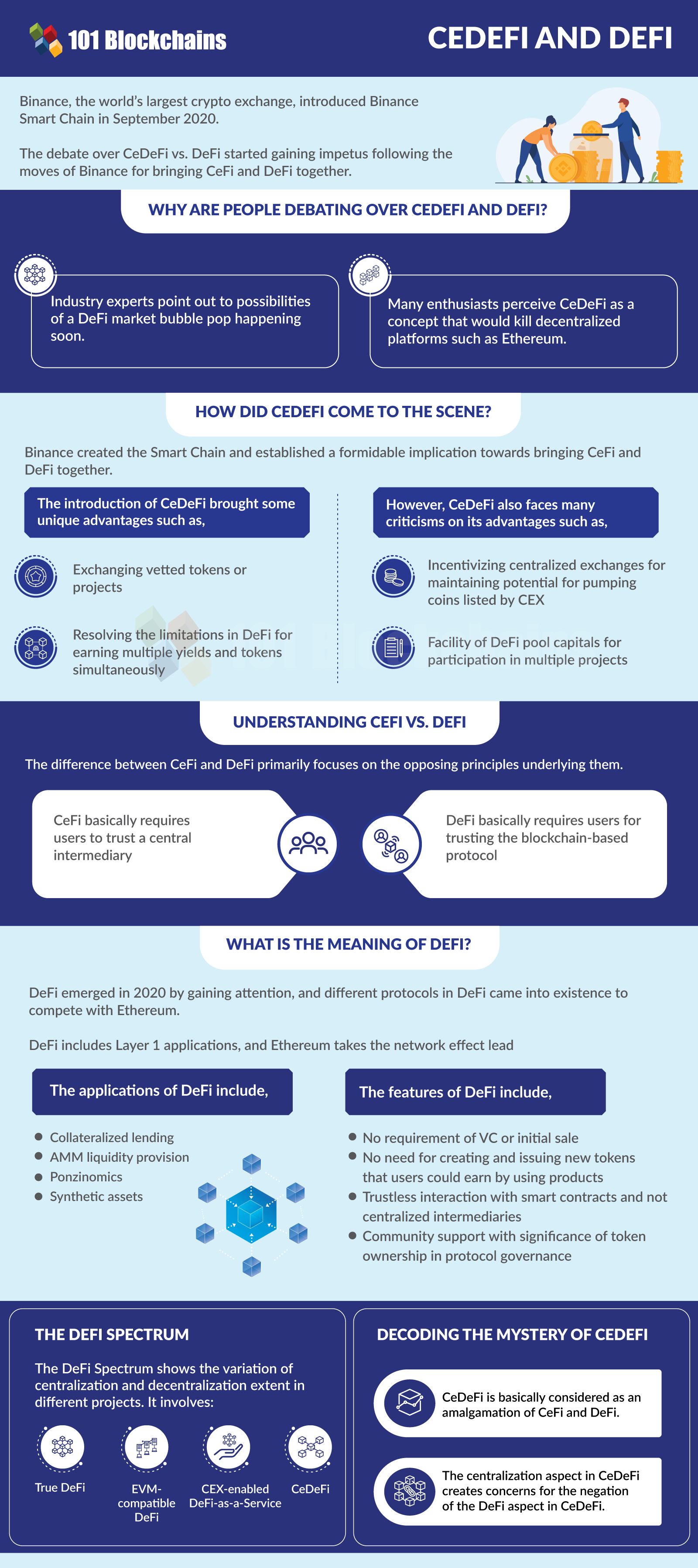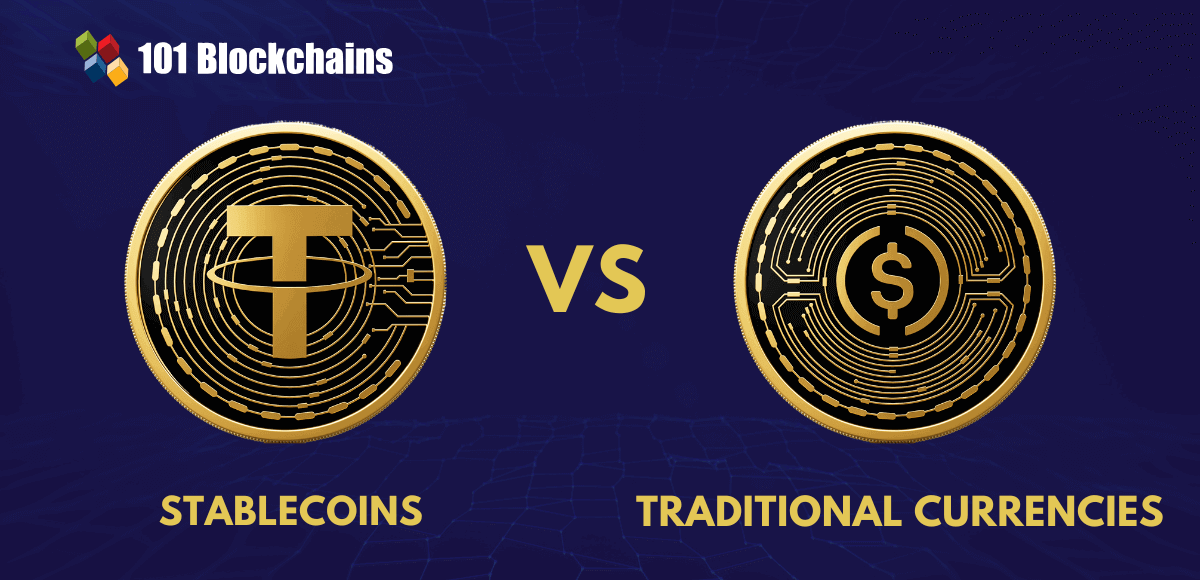Learn how blockchain truly works, master key definitions, and uncover what makes smart contracts so "smart." Dive into the fundamentals, gain valuable insights, and start your blockchain journey today!

- Comparisons
Gwyneth Iredale
- on March 22, 2021
Difference Between CeDeFi and DeFi – CeDeFi vs DeFi
The most critical concern for the majority of people all over the world primarily revolves around the changing dynamics of the financial ecosystem. At this point in time, the introduction of DeFi (Decentralized Finance) showed exceptional promise for increasing transparency in the financial ecosystem around the world. However, the arrival of centralized-DeFi can introduce new benchmarks in the world of finance. Therefore, the CeDeFi vs DeFi debate is slowly picking up the pace and attracting the attention of many all over the world.
So, where did the debate started picking momentum? The world’s largest crypto exchange, Binance, introduced the Binance Smart Chain as its venture into DeFi. While presenting the Binance Smart Chain, the founder of Binance, CZ, stated that the CeDeFi concept does not contradict DeFi. Quite an interesting turn of events, isn’t it? So, let us find out whether it is reasonable to discuss the implications of DeFi vs CeDeFi.
Enroll Now: DeFi Training Course
Why Are People Debating over CeDeFi and DeFi?
Please include attribution to 101blockchains.com with this graphic. <a href='https://101blockchains.com/blockchain-infographics/'> <img src='https://101blockchains.com/wp-content/uploads/2021/03/CeDeFi-and-DeFi.png' alt='CeDeFi vs DeFi' border='0' /> </a>
First of all, it is important to take the basic aim of CeDeFi into account for understanding its comparison with DeFi. The CeDeFi vs DeFi debate seems unreasonable as the former aims to bring the best of both CeFi or centralized finance and DeFi in a single portal.
According to the CEO and founder of Binance, CZ, Binance would establish a seed fund of USD 100 million for empowering emerging projects and fostering collaboration between the CeFi and DeFi landscapes. At the same time, it is also essential to consider the possibilities of a DeFi market bubble pop. The CEO of Messari, a leading crypto market data provider, has pointed out that the DeFi bubble pop can happen faster than expected.
The news of the DeFi bubble pop definitely adds fuel to the possibilities of DeFi vs CeDeFi battle. However, Binance is currently leading the CeDeFi movement and presenting many new prospects.
For example, Binance would call DeFi projects to submit their proposals for their USD 100 million seed fund. Binance has stated that the best projects have the chance of winning funding of around USD 100,000.
In addition, high-quality projects can have better chances of participating for being listed on Binance. The efforts of Binance in bridging the gap between DeFi and CeFi are also evident in the Token Canal project.
Binance is using the Token Canal project for working with the Binance Smart Chain community to support developers in connecting Binance Smart Chain with other public chains. Binance Smart Chain is the own dual-chain architecture of Binance. By linking Binance Smart Chain with different public chains, Binance can enable tokens on other chains for connecting to tokens on Binance. The notable tokens on other chains that you can connect with Binance tokens include Ethereum (ETH) and Bitcoin (BTC).
Also Read: Ethereum vs Bitcoin
How Did CeDeFi Come to the Scene?
The concept of CeDeFi has emerged with the Binance Smart Chain in the world of crypto. However, there is no point in the CeDeFi vs DeFi comparison as DeFi has its own set of appealing functionalities. On the other hand, CeFi is all set to present formidable competition for DeFi. Therefore, CeDeFi appears as the promising alternative for DeFi projects to continue their golden run.
- CeDeFi enables the exchange of vetted tokens or projects. A reputed centralized exchange takes on the responsibility of maintaining CeDeFi despite having vulnerabilities and potentially negative trends.
- Furthermore, CeDeFi can help in overcoming the limitations in DeFi for the selection of single projects. On the other hand, CeDeFi allows users to capitalize on CeFi for earning multiple tokens or yields simultaneously.
However, CeDeFi also faces certain criticisms when it comes to its two most prominent advantages. Critics point out that incentivizing centralized exchanges helps in maintaining the potential of pumping the coins listed by the CEX. Therefore, the users of CeDeFi would stick on for this particular reason. On the other hand, the lack of flexibility to focus on more than one single project with DeFi does not hold true in all cases.
The DeFi vs CeDeFi debate should also consider that the pools of capital with DeFi can enable participation in multiple projects. At the same time, users don’t have to worry about fund custody or central authority. Critics of CeDeFi also point out that users could expose only to an asset they want to hold on to for a long term with CeDeFi. Users would not have the ability to rush market buy BNB on the basis of an event, thereby reducing portfolio shift or allocation friction.
Want to explore in-depth about DeFi protocol and its use cases? Become a member and get free access to Decentralized Finance (Defi) Course- Intermediate Level Now!
Understanding CeFi vs DeFi
The difference in CeDeFi vs DeFi comparison should focus on understanding how CeFi and DeFi can come together for solving the problems with each. Binance, as a centralized exchange, cannot enter into the DeFi ecosystem. However, the CEO of Binance compared Bitcoin with Binance and stated that Bitcoin was decentralized and did not have any headquarters. The CEO definitely has promising reasons for making such arguments stating his involvement in running a centralized team.
The capabilities of running a centralized team for raising money by selling BNB tokens and promising for buyback of the tokens with revenue earned on the project characterize the Binance Smart Chain. The centralized exchange has also ventured into things such as FOMO listing SUSHI tokens, with formidable drama and swings regarding the price.
At the same time, Binance has also provided markets for BAL, YFI, CRC, and other DeFi tokens. One could notice the dominance of prospects for DeFi with the latest ventures of Binance, which also work well for the business of Binance. This is where you need to take a look at the individual concepts and the comparison between them for understanding DeFi vs CeDeFi in detail.
Want to learn more about the differences between CeFi and DeFi in detail? Check out our previous article CeFi vs DeFi and understand the differences in detail.
What Is the Meaning of DeFi?
Decentralized finance or DeFi started gaining attention in 2020. It did not achieve sudden recognition as it has constantly been growing over the course of many years. Various protocols have continued to establish decentralized systems over Ethereum, which are permissionless in nature alongside being useful. DeFi primarily includes layer 1 applications, with Ethereum taking the network effect lead.
The layer 1 applications have the capabilities to serve various financial purposes. The role of DeFi in the CeDeFi vs DeFi debate largely revolves around an understanding of its various financial purposes. First of all, DeFi is suitable for collateralized lending with Compound as a prominent example.
DeFi is an ideal instrument for developing synthetic assets such as UMA and Synthetix. In addition, users can also utilize DeFi for AMM liquidity provision with examples such as Curve, Uniswap, and Balancer. Another notable example that is clearly evident in the applications of DeFi refers to Ponzinomics such as Ampleforth alongside many other rebasing clones.
It is also important to notice the different characteristics of DeFi for establishing a stronger DeFi vs CeDeFi comparison. DeFi generally features the following traits, although not necessarily. First of all, it does not require a VC or initial sale. In addition, users don’t have to worry about creating and issuing new tokens that people could earn for using products. Another promising highlight that is evident with DeFi is the facility for trustless interactions with smart contracts rather than with centralized intermediaries.
Furthermore, DeFi also provides the feature of community support alongside implying the role of token ownership for governance of protocol. Presently, the most original DeFi project would obviously refer to YFI or Yearn Finance. YFI employs on-chain yield farming strategies and works just like the Berkshire Hathaway counterpart on DeFi.
If you are new to the term DeFi, first go through the introduction to DeFi to understand what is DeFi. Here’s the Beginner’s Guide to DeFi.
Where Does CeDeFi Stand?
The promising implications associated with decentralized finance or DeFi leave little room to wonder about its potential decline. However, we still have a CeDeFi vs DeFi debate at hand for a reason. In order to take our comparison of DeFi vs CeDeFi ahead, it is important to take a look at the immediate alternative, i.e., centralized finance or CeFi.
Centralized finance focuses on the role of a centralized intermediary for performing all the operations that you would execute with smart contract code on blockchain in DeFi projects. Centralized finance allows users to access many applications just like in DeFi. Some of the notable applications in the CeFi landscape include basic exchange applications and staking applications on an exchange.
In addition, CeFi also offers lending on the exchange applications, such as the example of Bitfinex. The most striking highlight of CeFi is that it puts users back in control in centralized financial systems. Users can interact directly with the centralized trusted intermediary responsible for taking custody of your funds for offering financial services.
Also Read: 30+ Best Decentralized Finance Applications
Decoding the Mystery of CeDeFi
Now that you know what DeFi and CeFi have to offer, you can work on identifying the implications of CeDeFi. Up till now, you must have developed the impression that CeDeFi is nothing more than a combination of CeFi and DeFi. At this point, you might wonder about bringing two completely contrasting entities together.
Will the introduction of centralization in DeFi with CeDeFi negate DeFi altogether? The user must maintain custody of their funds even while abiding by a smart contract. At the same time, highly renowned projects in the DeFi landscape focus largely on multisig wallets admins and small centralized development teams.
The DeFi Spectrum: Understanding CeDeFi vs DeFi
So, if you want to understand CeDeFi vs DeFi, you need to take a closer look at the DeFi spectrum. The DeFi spectrum moves from completely decentralized to completely centralized ecosystems. Let us take a look at the individual stages in the spectrum to understand the DeFi vs CeDeFi comparison effectively.
New to the Blockchain world? Get started with the Blockchain Fundamentals Presentation to know the basics and advanced concepts.
1. True DeFi
The first entry in the DeFi spectrum obviously refers to true DeFi projects, offering a maximum degree of decentralization. Generally, true DeFi projects involve a certain type of creator responsible for deploying the code. However, no one could fiddle with the code after it is deployed. Users have the ability to view source code in true DeFi.
At the same time, users can also anticipate the intended behavior alongside understanding the management of user funds. In addition, users could also identify the circumstances for withdrawing funds after using them. Majority of true DeFi projects are presently on Ethereum. On the other hand, you have an exception of Serum on Solana in true DeFi projects.
Aspiring to learn more about DeFi? Register now for the DeFi and Future of Finance webinar.
2. EVM-compatible DeFi
The next entry in the spectrum brings our attention to Binance Smart Chain and establishes the first impression of pointers from CeDeFi vs DeFi comparison. The EVM-compatible DeFi is the second stage in the DeFi spectrum after true DeFi projects. The EVM or Ethereum Virtual Machine-compatible DeFi projects present better centralization in comparison to Ethereum. They are actually smart contracts that run on Blockchain alongside enabling trustless asset swapping.
EVM-compatible DeFi projects have in-build EVM-compatible systems that allow Ethereum projects to port over their code easily. In addition, the examples of Binance Smart Chain show the use of MetaMask for ensuring cross-chain functionalities. The gradually increasing gas fees on Ethereum are slowly opening up the route for alternative layer 1 solutions and allowing EVM-compatible solutions with the best chance for porting over projects.
Want to know about the risks associated with DeFi? Check out our guide to risks in DeFi and how you can manage them right now!
3. CEX-enabled DeFi-as-a-Service
The third entry in the DeFi spectrum refers to the DeFi-as-a-Service offered by the centralized exchange. A centralized exchange or CEX platform leverages your funds for utilizing Ethereum DeFi projects such as Curve or Compound for earning yield. Users can create an additional layer of risk by trusting a CEX for conducting yield farming properly on-chain. However, you can also depend on platforms such as Binance for the same purpose if you don’t feel comfortable.
4. CeDeFi
The other extreme of the DeFi spectrum refers to CeDeFi. It is basically a centralized token-harvesting approach without any relation to DeFi. Users can stake BNB or other tokens on CEX platforms such as Binance. Then, users receive farmed tokens of projects promoted by Binance.
As a matter of fact, users don’t have to actually use CeDeFi projects for getting tokens. In addition, you don’t have any on-chain aspects with CeDeFi projects. It basically offers a reliable alternative for users scared of DeFi to farm their own tokens of actual decentralized projects.
Want to explore an in-depth understanding of security threats in DeFi projects? Become a member and get free access to DeFi Security Fundamentals Course Now!
Final Words
On the final note, you can note that the CeDeFi vs DeFi debate has started gaining attention with the new initiatives of Binance. Binance Smart Chain bears a close resemblance to Ethereum for allowing easy portability of projects such as CREAM. In the most basic sense, Binance Smart Chain features some level of DeFi, albeit with questions on its decentralization with the Proof of Stake Authority consensus.
People who are troubled by the excessive Ethereum gas fees for expensive smart contract transactions could opt for CeDeFi. If you want to learn more about CeDeFi, then you can visit us on 101 Blockchains right now. We recommend you to set the foundation with the DeFi course and then learn more about CeDeFi.





![30+ Best Decentralized Finance Applications [Updated] best decentralized finance (DeFi) applications](https://101blockchains.com/wp-content/uploads/2020/10/decentralized-finance-applications.png)